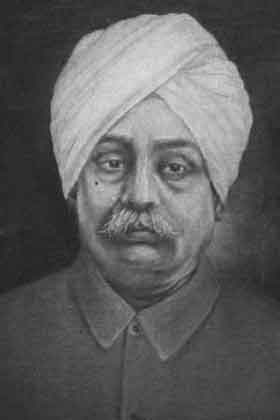Lala Lajpat Rai (28 January 1865 – 17 November 1928) was an Indian Punjabi author and politician who is chiefly remembered as a leader in the Indian Independence movement. He was popularly known as Punjab Kesari. He was part of the Lal Bal Pal tri organization.He was also associated with activities of Punjab National Bank and Lakshmi Insurance Company in their early stages. He sustained serious injuries by the police when leading a non-violent protest against the Simon Commission and died less than three weeks later. His death anniversary (17 November) is one of several days celebrated as Martyrs’ Day in India.
Lajpat Rai was born in Dhudike (now in Moga district, Punjab) on 28 January 1865.(The word ‘Lala’ is an honorific, applied to prominent Hindu men of the time.) His father was in the Aggarwal caste.Rai had his initial education in Government Higher Secondary School, Rewari (now in Haryana, previously in Punjab), in the late 1870s and early 1880s, where his father, Radha Krishan, was an Urdu teacher. Rai was influenced by Hinduism and created a career of reforming Indian policy through politics and writing.(When studying law in Kolkata, he continued to practice Hinduism. He became a large believer in the idea that Hinduism, above nationality, was the pivotal point upon which an Indian lifestyle must be based.) Hinduism, he believed, led to practices of peace to humanity, and the idea that when nationalist ideas were added to this peaceful belief system, a secular nation could be formed. His involvement with Hindu Mahasabha leaders gathered criticism from the Bharat Sabha as the Mahasabhas were non-secular, which did not conform with the system laid out by the Indian National Congress.This focus on Hindu practices in the subcontinent would ultimately lead him to the continuation of peaceful movements to create successful demonstrations for Indian independence. He was a devotee of Arya Samaj and was editor of Arya Gazette, which he set up during his student time.After studying law at the Government College in Lahore, Lajpat Rai practised at Hissar and Lahore, where he helped to establish the nationalistic Dayananda Anglo-Vedic School and became a follower of Dayananda Sarasvati, the founder of the reformist Hindu society Arya Samaj (“Society of Noble People”).
He did not fully recover from his injuries and died on 17 November 1928 of a heart attack. Doctors thought that Scott’s blows had hastened his death.However, when the matter was raised in the British Parliament, the British Government denied any role in Rai’s death.Although Bhagat Singh did not witness the event,he vowed to take revenge,and joined other revolutionaries, Shivaram Rajguru, Sukhdev Thapar and Chandrashekhar Azad, in a plot to kill Scott.However, in a case of mistaken identity, Bhagat Singh was signalled to shoot on the appearance of John P. Saunders, an Assistant Superintendent of Police. He was shot by Rajguru and Bhagat Singh while leaving the District Police Headquarters in Lahore on 17 December 1928.Chanan Singh, a Head Constable who was chasing them, was fatally injured by Azad’s covering fire.
This case of mistaken identity did not stop Bhagat Singh and his fellow-members of the Hindustan Socialist Republican Association from claiming that retribution had been exacted.
(Ref : https://en.wikipedia.org/wiki/Lala_Lajpat_Rai & Indus Library)
